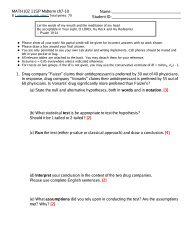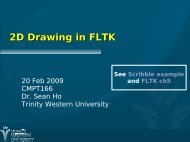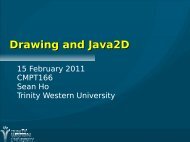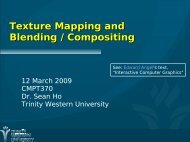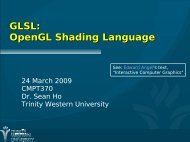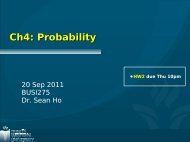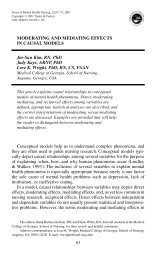Categorical Data Analysis and Meta-Analysis
Categorical Data Analysis and Meta-Analysis
Categorical Data Analysis and Meta-Analysis
Create successful ePaper yourself
Turn your PDF publications into a flip-book with our unique Google optimized e-Paper software.
<strong>Categorical</strong> <strong>Data</strong> <strong>Analysis</strong><br />
<strong>and</strong> <strong>Meta</strong>-<strong>Analysis</strong><br />
20 Nov 2009<br />
CPSY501<br />
Dr. Sean Ho<br />
Trinity Western University<br />
Download:<br />
● GenderDepr.sav<br />
● Fitzpatrick et al.<br />
● Hill & Lent
Outline for today<br />
<strong>Categorical</strong> <strong>Data</strong> <strong>Analysis</strong><br />
● Entering frequency data<br />
● Chi-squared test <strong>and</strong> effect sizes<br />
● SPSS example<br />
● Log-linear analysis example: Fitzpatrick 01<br />
● Interactions<br />
<strong>Meta</strong>-<strong>Analysis</strong><br />
● Combining effect sizes<br />
● Example: Hill & Lent (2006)<br />
CPSY501: log-linear; meta-analysis 20 Nov 2009<br />
2
Contingency Tables<br />
When comparing two categorical variables, all<br />
observations can be partitioned into cells of the<br />
contingency table<br />
● e.g., two dichotomous variables: 2x2 table<br />
● Gender vs. clinically depressed:<br />
Depressed<br />
Female 126 154<br />
Male 98 122<br />
Not Depressed<br />
● RQ: is there a significant relationship<br />
between gender <strong>and</strong> depression?<br />
CPSY501: log-linear; meta-analysis 20 Nov 2009<br />
3
SPSS: Frequency <strong>Data</strong><br />
Usually, each row in the <strong>Data</strong> View represents<br />
one participant<br />
● In this case, we'd have 500 rows<br />
For our example, each row will represent one<br />
cell of the contingency table, <strong>and</strong> we will<br />
specify the frequency for each cell<br />
Open: GenderDepr.sav<br />
<strong>Data</strong> → Weight Cases: Weight Cases by<br />
● Select “Frequency” as Frequency Variable<br />
CPSY501: log-linear; meta-analysis 20 Nov 2009<br />
4
2 <strong>Categorical</strong> Vars: χ 2 <strong>and</strong> φ<br />
Chi-squared (χ 2 ) test: Two categorical variables<br />
● Asks: is there a significant relationship?<br />
● Requires no cells have expected count ≤ 1,<br />
<strong>and</strong>
SPSS: χ 2 <strong>and</strong> φ<br />
Analyze → Descriptives → Crosstabs:<br />
● One var goes in Row(s), one in Column(s)<br />
● Cells: Counts: Observed, Expected, <strong>and</strong><br />
Residuals: St<strong>and</strong>ardized, may also want<br />
Percentages: Row, Column, <strong>and</strong> Total<br />
● Statistics: Chi-square, Phi <strong>and</strong> Cramer's V<br />
● Exact: (runs Fisher's exact test;<br />
computationally intensive)<br />
If χ 2 is significant, use st<strong>and</strong>ardized residuals<br />
(z-scores) to follow-up which categories differ<br />
CPSY501: log-linear; meta-analysis 20 Nov 2009<br />
6
Reporting χ 2 Results<br />
As in ANOVA, IVs with several categories<br />
require follow-up analysis to determine<br />
which categories show the effect<br />
● The equivalent of a pairwise comparison is a<br />
2x2 contingency table!<br />
Report:<br />
“There was a significant association between<br />
gender <strong>and</strong> depression, χ 2 (1) = ___, p < .001.<br />
Females were twice as likely to have depression<br />
as males.”<br />
● Odds ratio: (#F w/depr) / (#M w/depr)<br />
CPSY501: log-linear; meta-analysis 20 Nov 2009<br />
7
Log-Linear <strong>Analysis</strong><br />
Relationship among many categorical variables<br />
● Need not have IV/DV distinction<br />
Application of the General Linear Model<br />
(ANOVA, Regression) for several categorical<br />
variables<br />
● [ For dichotomous (0/1) variables,<br />
use log of probability of getting a “1” ]<br />
Look for moderation / interactions:<br />
● e.g., Employment * Gender * Depression<br />
CPSY501: log-linear; meta-analysis 20 Nov 2009<br />
8
Goodness of Fit<br />
Two χ 2 metrics measure how well our model<br />
(expected counts) fits the data (observed):<br />
● Pearson χ 2 <strong>and</strong> likelihood ratio (G)<br />
(likelihood ratio is preferred for small n)<br />
Significance test looks for deviation of observed<br />
counts from expected (model)<br />
● So if our model fits the data well, then the<br />
Pearson <strong>and</strong> likelihood ratio should be small,<br />
<strong>and</strong> the test should be non-significant<br />
SPSS tries removing various effects to find the<br />
simplest model that still fits the data well<br />
CPSY501: log-linear; meta-analysis 20 Nov 2009<br />
9
Hierarchical Backward Select'n<br />
By default, SPSS log-linear regression uses<br />
automatic hierarchical “backward” selection:<br />
Starts with all main effects <strong>and</strong> all interactions<br />
● For a “saturated” categorical model, all cells<br />
in contingency table are modelled, so the<br />
“full-factorial” model fits the data perfectly:<br />
likelihood ratio is 0 <strong>and</strong> p-value = 1.0.<br />
Then removes effects one at a time, starting<br />
with higher-order interactions first:<br />
● Does it have a significant effect on fit?<br />
● How much does fit worsen? (ΔG)<br />
CPSY501: log-linear; meta-analysis 20 Nov 2009<br />
10
Example: Fitzpatrick et al.<br />
Fitzpatrick, M., Stalikas, A., Iwakabe, S. (2001).<br />
Examining Counselor Interventions <strong>and</strong> Client<br />
Progress in the Context of the Therapeutic Alliance.<br />
Psychotherapy, 38(2), 160-170.<br />
Exploratory design with 3 categorical variables,<br />
coded from session recordings / transcripts:<br />
● Counsellor interventions (VRM)<br />
● Client good moments (GM)<br />
● Strength of working alliance (WAI)<br />
Therapy: 21 sessions, male & female clients &<br />
therapists, expert therapists, diverse models.<br />
CPSY501: log-linear; meta-analysis 20 Nov 2009<br />
11
Fitzpatrick: Research Question<br />
RQ: For expert therapists, what associations<br />
exist amongst VRM, GM, <strong>and</strong> WAI?<br />
Therapist Verbal Response Modes:<br />
● 8 categories: encouragement, reflection,<br />
self-disclosure, guidance, etc.<br />
Client Good Moments:<br />
● Significant (I)nformation,<br />
(E)xploratory, or (A)ffective-Expressive<br />
Working Alliance Inventory<br />
● Observer rates: low, moderate, high<br />
CPSY501: log-linear; meta-analysis 20 Nov 2009<br />
12
Fitzpatrick: Abstract<br />
Client “good moments” did not necessarily<br />
increase with Alliance<br />
Different interventions fit with<br />
good moments of client information (GM-I)<br />
at different Alliance levels.<br />
“Qualitatively different therapeutic processes<br />
are in operation at different Alliance levels.”<br />
Explain each statement <strong>and</strong> how it summarizes<br />
the results.<br />
CPSY501: log-linear; meta-analysis 20 Nov 2009<br />
13
Top-down <strong>Analysis</strong>: Interaction<br />
As in ANOVA <strong>and</strong> Regression, Loglinear analysis<br />
starts with the most complex interaction<br />
(“highest order”) <strong>and</strong> tests whether<br />
it adds incrementally to the overall model fit<br />
● Compare with ΔR 2 in regression analysis<br />
Interpretation focuses on:<br />
● 3-way interaction: VRM * GM * WAI<br />
● Then the 2-way interactions: GM * WAI, etc.<br />
Fitzpatrick did separate analyses for each of the<br />
three kinds of good moments: GM-I, GM-E, GM-A<br />
CPSY501: log-linear; meta-analysis 20 Nov 2009<br />
14
Results: Interactions<br />
2-way CGM-E x WAI interaction:<br />
● Exploratory Good Moments tended to occur<br />
more frequently in High Alliance sessions<br />
2-way WAI x VRM interaction:<br />
● Structured interventions (guidance) take<br />
place in Hi or Lo Alliance sessions, while<br />
● Unstructured interventions (reflection) are<br />
higher in Moderate Alliance sessions<br />
● Describes shared features of “working<br />
through” <strong>and</strong> “working with” clients,<br />
different functions of safety & guidance.<br />
CPSY501: log-linear; meta-analysis 20 Nov 2009<br />
15
CPSY501: log-linear; meta-analysis 20 Nov 2009<br />
16
<strong>Meta</strong>-<strong>Analysis</strong><br />
The APA journal has basic st<strong>and</strong>ards for<br />
literature review in many areas<br />
<strong>Meta</strong>-<strong>Analysis</strong> (MA) is a tool for combining<br />
results of quantitative studies in a systematic,<br />
quantitative way.<br />
Example <strong>Meta</strong>-<strong>Analysis</strong> journal article:<br />
● Hill, C. E., & Lent, R. W. (2006). A narrative <strong>and</strong><br />
meta-analytic review of helping skills training:<br />
Time to revive a dormant area of inquiry.<br />
Psychotherapy: Theory, Research, Practice,<br />
Training, 43(2), 154–172.<br />
CPSY501: log-linear; meta-analysis 20 Nov 2009<br />
17
MA Focuses on Effect Sizes<br />
Choose groups of studies <strong>and</strong> subgroups of<br />
studies to combine <strong>and</strong> compare<br />
g : difference between the means divided by<br />
the pooled st<strong>and</strong>ard deviation<br />
d : unbiased estimates of the population effect<br />
size as reported by each study<br />
CPSY501: log-linear; meta-analysis 20 Nov 2009<br />
18
Combining Effect Sizes: ex.<br />
Example: two correlation studies, with<br />
● r 1<br />
= .22 <strong>and</strong> r 2<br />
= .34<br />
● N 1<br />
= 125 <strong>and</strong> N 2<br />
= 43<br />
Combine studies to estimate r<br />
Unweighted average: (.22 + .34) / 2 = .28<br />
Weighted average by sample size:<br />
[ .22(125) + .34(43) ] / (125 + 43) = .25<br />
The larger sample has a smaller effect size!<br />
CPSY501: log-linear; meta-analysis 20 Nov 2009<br />
19
Persuasiveness of MA<br />
Quality of studies (design, etc.)<br />
Comparability of studies<br />
(variables, measures, participants, etc.)<br />
● Especially moderating factors!<br />
RQ: Differences among types of training?<br />
(instruction, modeling, feedback)<br />
Do we know the “amount” of training time<br />
examined in each study?<br />
What impact might these factors have on the<br />
interpretation of the meta-analysis?<br />
CPSY501: log-linear; meta-analysis 20 Nov 2009<br />
20
Hill & Lent (2006)<br />
p.159: Summary of strategy <strong>and</strong> symbols used<br />
p.160: List of studies being summarized<br />
(k = 14), including outcome measures, etc.<br />
Multiple measures were aggregated within each<br />
study by calculating a mean effect size <strong>and</strong><br />
st<strong>and</strong>ard error<br />
Use Cohen’s (1988) criteria for effect size:<br />
d=0.20 (small), d=0.50 (med), d=0.80 (large)<br />
CPSY501: log-linear; meta-analysis 20 Nov 2009<br />
21
Global analysis: outlier<br />
Hill & Lent chose to exclude one entire study as<br />
an outlier: p.161:<br />
“Given its potential to disproportionately<br />
influence effect sizes, especially in a relatively<br />
small set of studies, the outlier study was<br />
omitted in our subsequent analyses.”<br />
Now only 13 studies left …<br />
Pros & cons of this omission?<br />
CPSY501: log-linear; meta-analysis 20 Nov 2009<br />
22
Questions… pre-assignment<br />
Note: The same group of studies is used in all<br />
sections of Hill & Lent…<br />
How do the different research questions shape<br />
the MA calculations?<br />
How do confidence intervals help us interpret<br />
effect sizes (ES)?<br />
How do we integrate the results of different<br />
research questions?<br />
CPSY501: log-linear; meta-analysis 20 Nov 2009<br />
23
Formatting Tables in MS-Word<br />
Use the “insert table” <strong>and</strong> “table properties”<br />
functions of Word to build your tables; don’t do<br />
it manually.<br />
General guidelines for table formatting can be<br />
found on pages 147-176 of the APA manual.<br />
Additional tips <strong>and</strong> examples: see NCFR site:<br />
http://oregonstate.edu/~acock/tables/<br />
In particular, pay attention to the column<br />
alignment article, for how to get your numbers<br />
to align according to the decimal point.<br />
CPSY501: log-linear; meta-analysis 20 Nov 2009<br />
24



